10 Day itinerary in Bhutan, Asia
Matsutake Mushroom Festival Tour
The Haa Summer Festival takes place in July annually. It showcases a lively traditional living culture, nomadic lifestyle, demonstration of Bhutanese cuisines, processing of local ara (drink), traditional sports, religious performance, dances, songs, artefacts, and natural alpine flowers. This tour ... Read More


By Ugyen and Sangay
Overview
Physical Difficulty
Average
Recommended Age
Everyone
Operated in
English
GUIDANCE
Tour Guide, Driver
starting point
Paro
trip type
Private
trip attributes
Rural home stays
Yoga
Meditation
Hiking
Wellness retreat
Indigenous culture
Meet local people
Visit markets
Nature & Wildlife
Explorer Trips
Culture & Heritage
Purposeful Travel
Food & Culinary

Night

Highlights
Haa Alpine Summer Festival
The best attractions of Thimphu city
Hike to Bhutan’s famous Paro Taktshang Monastery (Tiger’s Nest)
Punakha, once the winter capital of Bhutan until 1955
Haa Alpine Summer Festival
The best attractions of Thimphu city
Hike to Bhutan’s famous Paro Taktshang Monastery (Tiger’s Nest)
Punakha, once the winter capital of Bhutan until 1955
Itinerary
Mid-Range
Accommodation Categories
Day 1
Arrive Paro
Flying into Bhutan offers the most spectacular views of the Himalayan ranges, including Mt. Everest (8,848m/29,028ft), Mt. Kanchenjunga (8,586m/28,169ft) and Mt. Gangkar Puensum (7,564m/24,836ft). On arrival we meet you at Paro International Airport after clearing your immigration and customs formalities. We’ll then travel (125-km) about 4 hours to Punakha, Bhutan's former winter capital until 1955. Nestled in western Bhutan, Punakha enjoys a temperate climate, bordered by Gasa to the north, Thimphu to the west, and Wangdue Phodrang to the east and south. Our first stop will be at the Druk Wangyal Chortens before crossing the Dochula Pass (3,050m). If weather permits, this spot provides awe-inspiring panoramic views of the snow-capped Himalayan peaks, including Bhutan’s highest, Mount Gangkar Puensum, towering at 7,564m. Continuing our picturesque journey for 52-km, we'll traverse the captivating landscapes of Punakha and Wangdue Phodrang Valley. In Punakha (1,350m), we'll explore Chimi Lhakhang, the fertility temple situated on a circular hillock near Sopsokha village. Built in 1499 by Saint Drukpa Kunley, known as the Divine Madman, this sacred site is believed to bless childless couples from across Bhutan and occasionally overseas, granting them children. Enjoy a delightful evening with the Bhutan Green Travel team, featuring a warm welcome drink and a delicious dinner to kickstart your journey in style. Overnight stay in Punakha.
Guide: Included for the day
Meals: Lunch, Dinner, Snacks

Day 2
Punakha
Discover the delights of Punakha–Wangdue Phodrang Valley, situated in western Bhutan with a warm and temperate climate. It is bordered by Gasa to the north, Thimphu to the west, and Wangdue Phodrang to the east and south, making it a popular tourist destination. Begin by driving (7-km) for about 30 minutes to the parking area by the Mochhu River before ascending to the majestic Khamsum Yulley Namgyal Chorten. Constructed in 1994 by Queen Mother Ashi Tshering Yangdon Wangchuk, this 100-ft tall temple is located on a strategic ridge, offering panoramic views of the terraced fields and countryside of Punakha Valley. From the parking area, cross a suspension bridge over the Mochhu River and walk through paddy fields to the base of the hill. Then, ascend a moderately inclined trail surrounded by pine trees, taking approximately 45 minutes to reach the top. In the afternoon, sightseeing includes a visit to the Punakha Dzong, strategically located at the confluence of the Phochhu (male) and Mochhu (female) Rivers. This grand fortress is adorned with jacaranda trees, coloring the landscape with vibrant purple blooms in spring. The evening can continue with a visit to the Sangchen Dorji Lhuendrup Nunnery Buddhist College in Wolakha, spectacularly located on a hilltop (25-minute drive from Punakha Dzong). Built in 2008 by the Queen Mothers' parents, the nunnery provides a space for nuns to pursue higher Buddhist studies. Overnight stay in Punakha.
Guide: Included for the day
Meals: Breakfast, Lunch, Dinner, Snacks
Accommodation:
- Mid-Range: 3* Hotel
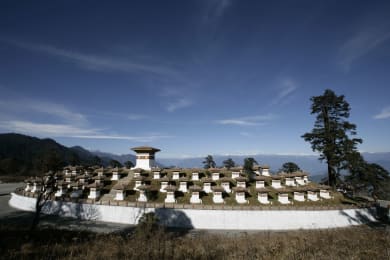
Day 3
Punakha – Bumthang
After an early breakfast, continue to the Bumthang Valley in central Bhutan, home to some of the oldest temples and monasteries in the country. Along the way, we pass by Wangdue Phodrang Dzong, overlooking the convergence of the Dangchhu and Punatsangchhu Rivers. Zhabdrung Ngawang Namgyal (founder of Bhutan) constructed the dzong in 1638, resembling that of a sleeping elephant. Although damaged by fire in 2012, reconstruction to its former splendour was completed in November 2022. Our journey takes us first to Trongsa about 4-5 hours via the scenic Pelela Pass (3,390m) and Nobding, a small town en route. Enjoy varied landscapes, from majestic mountains to lush greenery. Traveling along Bhutan's East–West highway, you may encounter grazing yaks, adding to the picturesque scenery. On the way take a stroll along the Chendebji Chorten below the road. A nice stop to stretch your legs and walk around the stupa! This 18th century monument resembles the Boudhanath Stupa in Kathmandu, Nepal with eyes painted at the four cardinal points. A highlight awaits at the Thumangdra viewpoint, offering a perfect vantage to capture breathtaking photos showcasing the scenic beauty of the landscapes and the grandeur of the dzong. Continue your journey to Bumthang (68-km) about 2.5 hours via Yotongla Pass (3,425m). You have an option to explore the Yathra Weaving Centre in Chumig village en route, where the Bumthap women weave yak and sheep wools into the beautifully patterned fabric called “Yathra” including woollen mattresses (Drumzeedhen). Overnight stay in Bumthang.
Guide: Included for the day
Meals: Breakfast, Lunch, Dinner, Snacks
Accommodation:
- Mid-Range: 3* Hotel
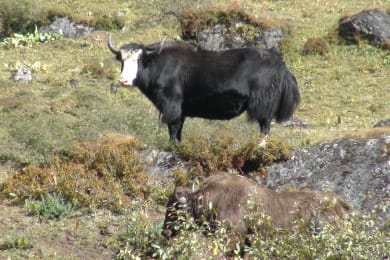
Day 4
Jakar Valley Gentle Walking
We will explore the pristine Bumthang Valley, also known as Jakar, revered as the religious heartland of Bhutan and home to some of the country’s oldest temples and monasteries. After breakfast, drive to Kenchosum Lhakhang, a historic 8th century temple. This sacred site is famed for its ancient relic— a broken bronze bell said to have been gifted by a mermaid. According to legend, the bell's sound could once be heard as far as Lhasa in Tibet when rung. The temple suffered extensive damage due to a butter-lamp fire in 2010 but was beautifully reconstructed, brightly painted, and re-consecrated in 2014. Inside, it houses three statues of Due-Sum-Sangay (the Buddhas of the Past, Present, and Future) and other revered relics. Next, visit Tamshing Lhakhang, a center for Nyingma Buddhist teachings founded in 1501 by Terton Pema Lingpa. From here, take a short walk and cross the bridge over the Chamkharchhu River to reach the Kurjey Lhakhang complex. This sacred site comprises three temples encircled by walls adorned with 108 chortens. Kurjey Lhakhang is where Guru Rinpoche meditated in the 8th century, subdued the local demon Phola Shelging Karpo, and healed the ailing King Sindhu Raja of Bumthang. Your next sightseeing is Jambay Lhakhang (Temple of Maitreya), believed to be one of 108 temples built in a single day by Tibetan King Songtsen Gampo in the 7th century. This temple is steeped in history and mythology, having been constructed to suppress the evil spirits of a demoness hindering the spread of Buddhism. Today, enjoy an authentic traditional Bhutanese meal at Sherab Dema Farmhouse, where you can try your hand at archery or relax in a soothing traditional hot stone bath. Overnight stay in Bumthang.
Guide: Included for the day
Meals: Breakfast, Lunch, Dinner, Snacks
Accommodation:
- Mid-Range: 3* Hotel

Day 5
Bumthang – Phobjikha
After breakfast, our return journey takes us to Phobjikha Valley via Trongsa, enjoying a scenic drive lasting approximately 5-6 hours. Trongsa holds a profound legacy, as every Bhutanese monarch traditionally assumes the role of Trongsa Penlop before ascending the throne. Trongsa Dzong built in 1648, is the largest fortress in Bhutan, commanding a view over the Mangdichhu River gorge. Its majestic architecture, characterized by a distinctive yellow roof, is a testament to Bhutan's rich cultural heritage. Additionally, the Tower of Trongsa (known as Ta Dzong) stands tall as an ancient watchtower, offering captivating views of Trongsa town and its surroundings. Arrive in Phobjikha, take the opportunity to visit Gangtey Gonpa, a picturesque 17th century monastery perched on a hillock, offering breathtaking views of the valley. The monastery is the only Nyingmapa School of Buddhism taught here in western Bhutan. Phobjikha Valley is a haven for nature enthusiasts and is renowned as the winter habitat for rare, Black-Necked Cranes, migrating from the Tibetan plateau from late October to mid-March. Later in the day, you can explore the beautiful valley surrounded by pine forests, meet the locals, and visit the Black-necked Crane Information Centre to learn about the migrating birds. Overnight stay in Phobjikha.
Opt for a Village Homestay for a unique experience in a vibrant, traditionally built Bhutanese farmhouse. These 2-storey homes are adorned with colourful decor and equipped with decent amenities such as toilets, showers, and hot stone baths. Service providers are trained in basic housekeeping and hygiene for tourists. Enjoy the immersive experience of living in a village house, where the housemother personally serves food and drinks, creating a familial atmosphere. Interact with locals and engage in daily village activities.
Guide: Included for the day
Meals: Breakfast, Lunch, Dinner, Snacks
Accommodation:
- Mid-Range: 3* Hotel
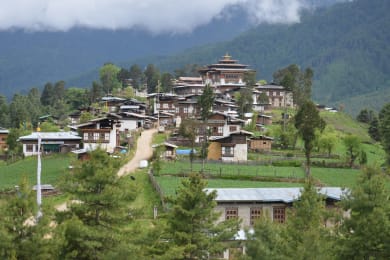
Day 6
Phobjikha – Thimphu [135-km/5 Hr]
This morning, we begin our return journey to Thimphu, the capital of Bhutan. Along the way, we'll stop at Dochula Pass, situated at an elevation of 3,050m. Renowned for its breathtaking views, the pass features the iconic Druk Wangyal Chortens, a collection of 108 stupas, as well as 11 man-made hidden "Igloo-Caves," each adorned with unique paintings depicting various gods and goddesses. Many visitors seeking inner peace amid modern-day stresses come here for meditation. For Buddhists, meditation is often pursued as a path to enlightenment and nirvana. Continuing our journey, we arrive in Thimphu city, located at an altitude of 2,300m. Unlike the concrete jungles of other capitals, Thimphu lies nestled in a serene rural valley, surrounded by stunning natural beauty and featuring traditional Bhutanese architecture. Experience the city’s unique traffic control system, where police officers direct traffic with elegant hand signals instead of lights. Upon arrival, visit the Centenary Farmers Market, a vibrant marketplace where Bhutanese farmers sell fresh local produce, arts, and crafts. The evening is free for you to relax, explore the sights of the capital, shop, or soak in the festive atmosphere of Thimphu. Overnight stay in Thimphu.
Guide: Included for the day
Meals: Breakfast, Lunch, Dinner, Snacks
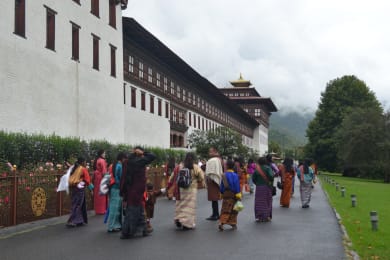
Day 7
Thimphu
Today we explore the best attractions of Thimphu city (2,300m), home to approximately 138,736 inhabitants. Morning begins with a visit to the National Memorial Chorten (stupa), built in 1974 in honour of the Third King Jigme Dorji Wangchuk (1928-1972). This stupa is a prominent monument for Bhutanese daily worship in the city with its golden spires and bells. Another must-see place to tick off your list is Kuenselphodrang, home to the 169-foot Buddha Dordenma statue, the largest of its kind, which was erected in 2006. Our next stop is at the Motithang Takin Reserve, home to Bhutan's national animal, followed by the National Institute for Zorig Chusum, established in 1971 where students are taught the 13 traditional arts and crafts of Bhutan. Proceed to the nearby National Library of Bhutan, established in 1967, located in the cultural center of Thimphu, the capital of Bhutan. Here, you'll find the world's largest book, Bhutan: A Visual Odyssey Across the Last Himalayan Kingdom. It weighs over 60 kg, stands 1.52 meters high, and spans 2.13 meters wide. Its pages are turned once a month. We then continue to the Bhutan Postal Museum, a must-visit for philatelists and those looking to purchase postcards and stamps. If time permits, visit the Tashichhodzong, initially constructed in 1216 and rebuilt in 1641 by Shabdrung Ngawang Namgyal. This iconic fortress now houses several government ministries, the office and throne room of His Majesty the King, and the Central Monk Body. Overnight stay in Thimphu.
Guide: Included for the day
Meals: Breakfast, Lunch, Dinner, Snacks
Accommodation:
- Mid-Range: 3* Hotel
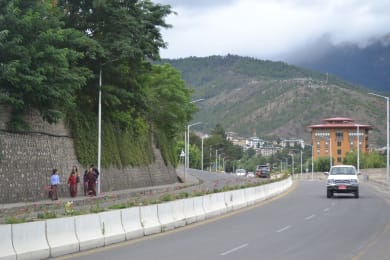
Day 8
Matsutake Mushroom Festival in Genekha
Today, attend the Genekha Matsutake Mushroom Festival, held annually in August. This two-day festival is an exciting event that celebrates the region's rich culture and diverse communities. Renowned for its abundance of matsutake and chanterelle mushrooms, the festival promotes sustainable mushroom harvesting and showcases local cuisines. Activities include indigenous sports, product stalls, culinary delights such as mushroom soup and curry, and cultural performances like mask dances, folk dances, and skits by nearby schools (a detailed program list will be provided on the day). The festival offers a unique opportunity for food enthusiasts and nature lovers to experience Bhutan's untouched beauty. Explore the traditional Bhutanese villages, adorned with beautiful houses and temples, and immerse yourself in the distinctive culture of the valley. There are also plenty of hikes and treks in the area, and it is also the starting point for the Dagala Thousand Lake Treks. In the evening, we will drive back to Paro for your overnight stay. If time permits, you can relax or explore the charming sights of Paro town and its surroundings.
Guide: Included for the day
Meals: Breakfast, Lunch, Dinner, Snacks
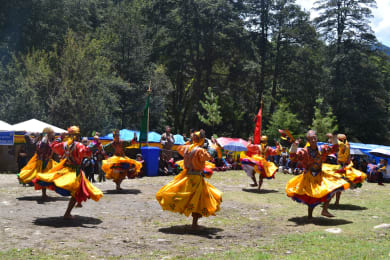
Day 9
Hike to Tiger’s Nest Monastery
Your tour ends this morning after breakfast. We transfer you to Paro International Airport for your onward journey. Our guide and driver from Bhutan Green Travel will see you off. Tashi Delek (Goodbye and Good Luck)!Bhutan’s famous Paro Taktshang Monastery (Tiger’s Nest) is an unforgettable sight. No visit to Bhutan would be complete without a trip to Paro Taktshang (3,120m). The monastery is perched on the edge of a steep cliff, 900m above the Paro floor valley. The hike (4-km) starts at the base of the mountain from the road point at Ramthangkha, 12-km from the Paro town. Expect a walking duration of around 4-5 hours for the complete round-trip hike, along with an additional hour allocated for touring the monastery at a comfortable pace. Gentle horse or pony rides are offered as a transport option halfway up the trail. Gentle horse/pony rides are available for transport halfway up the trail, where you will be treated to a breathtaking vantage point showcasing the monastery perched on the cliff wall. The latter part of the afternoon is free for leisure. Consider indulging in a hot stone bath at a farmhouse for a relaxing experience. Spend the night in Paro.
Guide: Included for the day
Meals: Breakfast
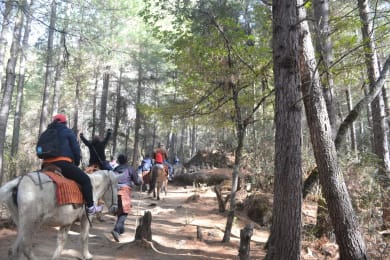
Day 10
None
None
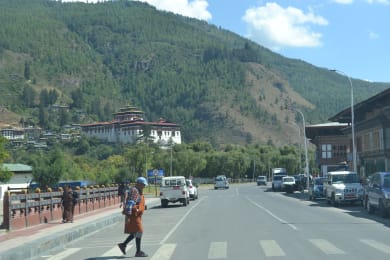
What’s Included
Accommodation
- 3* Hotel
Meals
- Lunch (8)
- Dinner (8)
- Snacks (8)
- Breakfast (8)
Transport
- Comfortable transport (private vehicle) throughout your trip
- Pickups and drops from airports and hotels
Activities
- All sightseeing & hiking/trekking (entrance fees to museums and other attractions)
Extras
- Camping facilities and haulage for trekking tours
- Baggage handling at all hotels and camps
- All applicable internal taxes and service fees
- Visa fee USD $40 (non-refundable)
- Sustainable development fee (SDF) $200 per night
Not Included
- International and domestic flights
- Travel insurance
- Discretionary tips for guides and drivers
- Upgrade to luxury properties (4 star and 5 star hotels)
- Single room supplement from USD $50 per night
- Optional activities & additional services
- Other personal expenses such as alcoholic drinks & beverages, laundry, telephone calls, etc.
About Ugyen
TEAM LEAD


+1 Local experts
Baboo Certified
4.93 (15 reviews)
Cycling
Hiking
Rafting
Visit markets
Meet local people
Rural home stays
Indigenous culture
Yoga
Meditation
Wellness retreat
Culture & History
Kayak & Canoe
Nature & Wildlife
Purposeful Travel
Food & Culinary
Hello everyone! I am the founder of Bhutan Green Travel. As a former civil servant working for the National Tourist Board of Bhutan and over 12 years of running my own travel company, there is not a corner in Bhutan I haven't explored.
Travel that Makes a Difference
By choosing to travel with us, you support local communities, wildlife, and the environment. We are dedicated to positively impacting the world through every journey we offer.

Let’s regenerate the planet together
We overcompensate your entire journey’s carbon footprint including flights - for free.
$3,647.00 USD